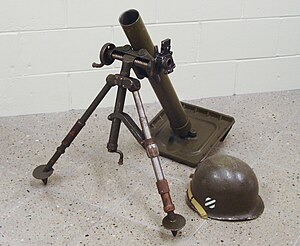M2 mortar
| US M2 60 mm Mortar | |
|---|---|

World War II era 60 mm U.S. M2 Mortar, G.I. helmet shown for scale
|
|
| Type | Infantry mortar |
| Place of origin |
|
| Service history | |
| Wars | World War II, Korean War, Vietnam War |
| Production history | |
| Designer | Edgar Brandt |
| Variants | Type 31 |
| Specifications | |
| Weight | 19.05 kg (42 lb) |
| Barrel length | 726 mm (2 ft 5 in) |
| Crew | 3 (Mortar Squad Leader, Gunner, Loader) + Ammo Carriers |
|
|
|
| Shell | 3 lb (1.4 kg). |
| Caliber | 60 mm (2.36 in) |
| Elevation | +40° to +85° |
| Traverse | 7° |
| Rate of fire | 18 rounds/minute |
| Muzzle velocity | 158 m/s (518 ft/s) |
| Maximum firing range | 1,815 m (1,985 yards) |
The M2 Mortar is a 60 milimeter smoothbore, muzzle-loading, high-angle-of-fire weapon used by U.S. forces in World War II, the Korean War, and the Vietnam War for light infantry support.
The U.S. M2 60 mm mortar was developed from the heavier 81 mm M1 Mortar to provide a lighter-weight alternative to company-level fire support. The M2 attempted to bridge the gap between the 81 mm mortar and the hand grenade. Normally employed by the weapons platoon of a U.S. infantry company, the M2 is of the usual mortar pattern of the day. It consists of a smoothbore metal tube on a rectangular baseplate, supported by a simple bipod with the elevation and traverse mechanisms. The firing pin was fixed in the base cap of the tube, and the bomb was fired automatically when it dropped down the barrel. Though classed as a light mortar, the M2 had considerable range compared to the 50 mm and 60 mm mortars of most other nations, and its fixed-firing pin design allowed a high rate of fire by trained crews.
During the late 1920s, the US Army began examining mortars to act as a light infantry support weapon. The War Department eventually settled on a 60 mm design from Edgar Brandt, a French ordnance engineer, and purchased a license to build the weapon. The model was standardized as the Mortar, 60 mm M2. Testing took place in the late 1930s, and the first order for 1,500 M2 mortars was placed in January 1940.
The weapon was used throughout World War II by the U.S. Army and U.S. Marine Corps. It saw service again in the Korean War, and by French forces in counterinsurgency campaigns in Indochina and Algeria. During the Vietnam War, the M2 was again used by the U.S. Army and Marines, as well as by South Vietnamese forces. Ultimately, the M2 was replaced by the M224 in 1978.
...
Wikipedia
